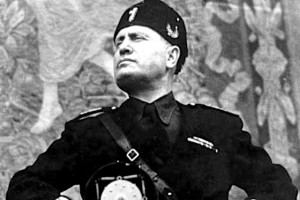“The war you fought…was one of neither glory nor grandeur. It was a war for survival, a war to live long enough to see the sun come up the next day or to wake up to the feeling of rain on your skin. A war for bread, a war against the cold, a war for a dry place to sleep. A war that has no borders to defend, no bridges to destroy: the war of life.”–Dr. Modo, medical examiner, to the body of Matteo Diotallevi, “Tette,” about seven years of age.
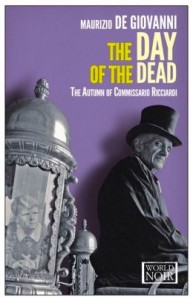 When the body of a thin little orphan, guarded by a small dog, is discovered in an alcove at the base of the Tondo di Capodimonte staircase in Naples, Commissario Luigi Alfredo Ricciardi di Malomonte is on the case. It is 1930, and Naples is preparing for the imminent arrival of Il Duce, Benito Mussolini, Italy’s ruler. It would not do for Naples to appear to be anything other than the perfect fascist city – a city with no crime – when Il Duce (pejoratively referred to here as “Thunder Jaw”) makes his appearance, and the powers in charge of security want no complications. Commissario Ricciardi, investigating this case, possesses a kind of extrasensory perception regarding death. If he appears at the location of a violent death and has a moment to communicate with the body, he is able to hear the victim’s last cryptic thought. By concentrating on possible hidden meanings revealed in this thought, he and Brigadier Maione, his only friend, gain important clues to understanding the victim’s last moment. In this case, however, no ghostly image appears and no last words are discernable when Ricciardi communes with the boy’s body, and he does not understand why.
When the body of a thin little orphan, guarded by a small dog, is discovered in an alcove at the base of the Tondo di Capodimonte staircase in Naples, Commissario Luigi Alfredo Ricciardi di Malomonte is on the case. It is 1930, and Naples is preparing for the imminent arrival of Il Duce, Benito Mussolini, Italy’s ruler. It would not do for Naples to appear to be anything other than the perfect fascist city – a city with no crime – when Il Duce (pejoratively referred to here as “Thunder Jaw”) makes his appearance, and the powers in charge of security want no complications. Commissario Ricciardi, investigating this case, possesses a kind of extrasensory perception regarding death. If he appears at the location of a violent death and has a moment to communicate with the body, he is able to hear the victim’s last cryptic thought. By concentrating on possible hidden meanings revealed in this thought, he and Brigadier Maione, his only friend, gain important clues to understanding the victim’s last moment. In this case, however, no ghostly image appears and no last words are discernable when Ricciardi communes with the boy’s body, and he does not understand why.
The fourth novel of the Inspector Ricciardi series by Maurizio de Giovanni, The Day of the Dead picks up all the continuing threads from the first three novels (I Will Have Vengeance, Blood Curse, and Everyone in Their Place) and draws them together. Ricciardi, now age thirty-one and the son of a Baron, is still living with his “Tata Rosa,” who has taken care of him since his mother died when he was a child. His only real romantic attachment is to a young woman he admires from afar and who lives across the alleyway from his apartment. While Ricciardi is shyly working out how to contact this young woman named Enrica, Livia Vezzi, the widow of the world’s greatest tenor, whose murder Ricciardi solved in I Will Have Vengeance, has moved to Naples and has set her cap for Ricciardi. In his professional life, his perennial difficulties with the authorities continue, primarily because he does not fear them or the loss of his job.
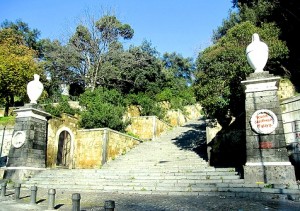
Staircase at the Tondo de Campodimonte, with the small alcove at the bottom left, where Tette’s body and his little dog are found.
This novel is different from the first three novels. Despite the often gruesome murders in those books, De Giovanni’s dry humor has always provided a kind of playfulness, almost a “literary wink,” to keep the reader of those novels intrigued (and sometimes amused), rather than repelled by the often hideous crimes. Here, from the outset, however, the author creates the darkest of moods, with no humor, using the pathos of the death of a tiny orphan boy, protected by his only friend, a small dog, to create a constant pull on the reader’s heartstrings. The orphan, Matteo Diotallevi, called “Tette” because he stutters and stammers so badly that he cannot say his own name, is one of thousands, “maybe hundreds of thousands,” of homeless street children in Naples in the early 1930s – children running shoeless, hungry, and without warm clothing in winter’s rains and sleet. Some, like Tette, are provided with a place to sleep at night, in this case a back room at a church, which offers shelter for six boys, but no love; little, if any, food (which the older bullies steal from the younger boys); and even less preparation for adult life. Some of the priests who are in charge of these facilities are less than scrupulous about their record-keeping and their own involvement with their charges. The children have no escape.
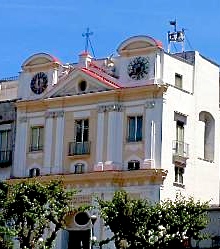
Santa Maria del Soccorso, where Don Antonio runs the church and the orphans’ dormitory. The name of the church is ironic. “Soccorso” means ‘”aid, relief, help.”
With starving children as the controlling idea of the plot, there is no relief for the reader from the overwhelming sadness in the lives of these children. As details of Tette’s life emerge, the novel resembles an opera far more than classic noir. Some of the subplots further increase the dark sentimentality by illustrating the lives of the elite (including the clergy) and the contrasts they offer to the lives of the children. Livia Vezzi, the wealthy widow of the world’s greatest tenor, is angling for the romantic attentions of Ricciardi, and she is now planning an elaborate party for her friend Edda Mussolini Ciano, newly married daughter of Il Duce. Her elegant lifestyle, like that of the rest of the aristocracy, combines with her lack of interest in the lower classes to emphasize the gap between the rich and poor.
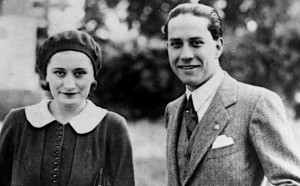
Edda Mussolini Ciano and her husband Count Galeazzo Ciano were expected to attend a party given by Livia Vezzi in 1930. Ciano was executed by his father-in-law in 1944.
The connivance of some of the clergy with the fascists, and the clergy’s blatant use of the curia to warn off investigators who might uncover some unsavory misdeeds also become issues. Even Ricciardi, in private life a baron with a large estate, does little in the way of action to help improve the lot of the poor, despite his stated empathy and the fact that Tette’s little dog, an obvious symbol, follows Ricciardi everywhere. The author provides additional insights into the personal life of Tette through a series of ten flashbacks leading up to his death, a technique which further conveys the horrors the child has lived through from his point of view.
Maurizio de Giovanni, a young writer whose descriptive talents develop more fully in this novel, with its memorable details about the coldness of winter’s approach and its psychological effects on the inhabitants, matches the moods of his novels to the seasons in which they take place. This novel, taking place in autumn, emphasizes change and the death of summer’s bounty, leading to the coldness of winter, a symbol which readers of this novel will not be able to ignore: The devastating conclusion comes like a blast of Arctic air, and it is virtually guaranteed to shock long-time fans of the first three novels.
ALSO by de Giovanni (Inspector Ricciardi series): I WILL HAVE VENGEANCE (#1), BLOOD CURSE (#2), EVERYONE IN THEIR PLACE (#3), BY MY HAND (#5), VIPER (#6), THE BOTTOM OF YOUR HEART (#7) GLASS SOULS: MOTHS FOR COMMISSARIO RICCIARDI (#8), NAMELESS SERENADE (#9),
Inspector Lojacono series: THE CROCODILE (#1), THE BASTARDS OF PIZZOFALCONE (#2), DARKNESS FOR BASTARDS OF PIZZOFALCONE (#3), COLD FOR THE BASTARDS OF PIZZOFALCONE (#4), PUPPIES (#5)
Photos, in order: The author’s photo appears on http://favoritethings.it
The staircase at the Tondo de Capodimonte, with the alcove hiding the body of little Tette and his dog, is from http://www.scaledinapoli.com/
Santa Maria del Soccorso, which means “Saint Mary of Aid, Relief, Help,” the place where Don Antonio was priest and head of the dormitory where the orphans lived, may be found at http://www.naplesldm.com
Edda Mussolini Ciano and her husband Count Galeazzo Ciano, in happier days, planned to attend the party given by Livia Vezzi. He was eventually executed by Mussolini, his father-in-law: http://dingeengoete.blogspot.com/
Benito Mussolini, “Thunder Jaw,” is shown on http://leavingcerthistory.net/
ARC: Europa Editions

